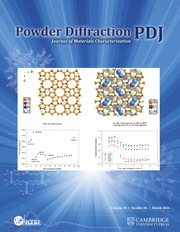Crossref Citations
This article has been cited by the following publications. This list is generated based on data provided by
Crossref.
Bertrand, L.
Vantelon, D.
and
Pantos, E.
2006.
Novel interface for cultural heritage at SOLEIL.
Applied Physics A,
Vol. 83,
Issue. 2,
p.
225.
Young, M.L.
Casadio, F.
Schnepp, S.
Almer, J.
Haeffner, D.R.
and
Dunand, D.C.
2006.
Synchrotron X-ray diffraction and imaging of ancient Chinese bronzes.
Applied Physics A,
Vol. 83,
Issue. 2,
p.
163.
Friedman, Elizabeth S.
Brody, Aaron J.
Young, Marcus L.
Almer, Jon D.
Segre, Carlo U.
and
Mini, Susan M.
2008.
Synchrotron radiation-based x-ray analysis of bronze artifacts from an Iron Age site in the Judean Hills.
Journal of Archaeological Science,
Vol. 35,
Issue. 7,
p.
1951.
Paszkowicz, Wojciech
2009.
Genetic Algorithms, a Nature-Inspired Tool: Survey of Applications in Materials Science and Related Fields.
Materials and Manufacturing Processes,
Vol. 24,
Issue. 2,
p.
174.
Young, M. L.
Casadio, F.
Schnepp, S.
Pearlstein, E.
Almer, J. D.
and
Haeffner, D. R.
2010.
Non-invasive characterization of manufacturing techniques and corrosion of ancient Chinese bronzes and a later replica using synchrotron X-ray diffraction.
Applied Physics A,
Vol. 100,
Issue. 3,
p.
635.
YOUNG, M. L.
CASADIO, F.
MARVIN, J.
CHASE, W. T.
and
DUNAND, D. C.
2010.
AN ANCIENT CHINESE BRONZE FRAGMENT RE‐EXAMINED AFTER 50 YEARS: CONTRIBUTIONS FROM MODERN AND TRADITIONAL TECHNIQUES.
Archaeometry,
Vol. 52,
Issue. 6,
p.
1015.
Grolimund, D.
Berger, D.
Bolliger Schreyer, S.
Borca, C. N.
Hartmann, S.
Müller, F.
Hovind, J.
Hunger, K.
Lehmann, E. H.
Vontobel, P.
and
Wang, H. A. O.
2011.
Combined neutron and synchrotron X-ray microprobe analysis: attempt to disclose 3600 years-old secrets of a unique bronze age metal artifact.
Journal of Analytical Atomic Spectrometry,
Vol. 26,
Issue. 5,
p.
1012.
Young, Marcus L
2012.
Archaeometallurgy using synchrotron radiation: a review.
Reports on Progress in Physics,
Vol. 75,
Issue. 3,
p.
036504.
Stock, Stuart R.
2012.
Characterization of Materials.
p.
1.
Notis, Michael
Newbury, Brian
Stephenson, Bruce
and
Stephenson, G. Brian
2013.
Synchrotron X-ray diffraction and fluorescence study of the astrolabe.
Applied Physics A,
Vol. 111,
Issue. 1,
p.
129.
Carl, Matthew
and
Young, Marcus L.
2016.
Complementary analytical methods for analysis of Ag-plated cultural heritage objects.
Microchemical Journal,
Vol. 126,
Issue. ,
p.
307.
Van Loon, Lisa L.
Banerjee, Neil R.
Hinds, Michael W.
Gordon, Robert
Bevan, George
and
Burgess, R. W.
2018.
Rapid, quantitative, and non-destructive SR-WD-XRF mapping of trace platinum in Byzantine Roman Empire gold coins.
Journal of Analytical Atomic Spectrometry,
Vol. 33,
Issue. 10,
p.
1763.
Jardine, Boris
and
Nall, Joshua
2023.
The Lab in the Museum. Or, Using New Scientific Instruments to Look at Old Scientific Instruments.
Centaurus,
Vol. 65,
Issue. 2,
p.
261.
Quintero Balbas, Diego
Cattaneo, Barbara
Cagnini, Andrea
Belluzzo, Paolo
Rossi, Sandra
Fontana, Raffaella
and
Striova, Jana
2023.
The Degradation of Daguerreotypes and the Relationship with Their Multi-Material Structure: A Multimodal Investigation.
Sensors,
Vol. 23,
Issue. 9,
p.
4341.

